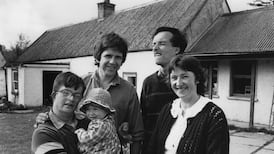It’s almost 30 years since Jean Butler and Michael Flatley first took our collective breaths away as the best-ever Eurovision interval act; and 25 since the Riverdance show got on the road. With more than 10,000 performances across six continents under its Celtic belt, lead Riverdancer Brandon Asazawa tells us how to shake a leg.
I bet you have to be dancing from the cradle
I’m afraid that’s kinda true. Born in the Cleveland Ohio, Asazaw’s father is Japanese. He credits his mother’s Irish lineage for setting him on the path to glory. A family VHS tape of Riverdance had him dancing round the living room and, he recalls, “my parents knew they needed to get me into classes”. He was enrolled at the age of four.
Damn! Does that mean you’re washed up by five?
READ MORE
Not quite. Asazawa generously mentions some dancers who didn’t start until the relatively old age of 12. After leaving school, he got work in other Irish dancing shows, before auditioning for Riverdance.
Auditioning for Riverdance?! How do you even actually get there?
Riverdance is such an institution, they unsurprisingly have systems in place. And possibly even more unsurprisingly, there is an entry fee to take part. “I auditioned at the first ever Riverdance Summer School back in 2015,” Asazawa explains. “Hundreds of dancers will attend with hopes of joining the show.” He describes a gruelling process, but one which ended with him being one of the few selected to join the tour. A six-day summer school in Dublin costs €650, while the junior school, aimed at ages six to 11 is €249 (academy.riverdance.com). There are plenty of Irish dancing studios around the country, but do note, Riverdance, while based on traditional Irish dance, added upper body movement, and brought in what Asazawa describes as “military precision”, so it is a little different.
[ Riverdance rebounds from Covid losses with profits of €2mOpens in new window ]
Is it hard work?
You’re looking at a lot of travel, and about eight shows a week. Strains, sprains and injuries are part and parcel of it all, although a physio and massage therapist are on hand. You also have to think of the future. The transition into “normal life” after your touring career is over can be tricky, says Asazawa, who recognises it is a finite career. “Like many of the dancers in the show, Riverdance has been the dream since I was a child. We have worked our entire lives to get to this point.”
So I did start at four, and I’m still going. What do I do next?
“Stay dedicated and never allow a ‘no’ to discourage you,” says Asazawa, who adds that he has had “countless rejections or failures, in competitions and in my professional career. There is always a way to get to where you want to be, as long as you stay hungry and passionate about what you do.”
What about help and networks?
Asazawa says that social media is a powerful connector, and many of the troupe are generous mentors. “The Riverdance social media team will tag us in posts, so people can find our Instagram handles. I love answering questions young dancers have about how to audition for the show, or how to improve their chances of getting cast,” he says. “There were many mentors I had throughout my journey and I would not be here without their guidance. My best advice is to connect and share your journey with anyone willing to help.” And if all else fails, or you’re already more than four, there’s still the dancing round the living room option. Kick those legs high.
The 25th Anniversary Riverdance show is at The Gaiety, Dublin until September 10th. riverdance.com















